Showing 1–36 of 42 resultsSorted by price: high to low
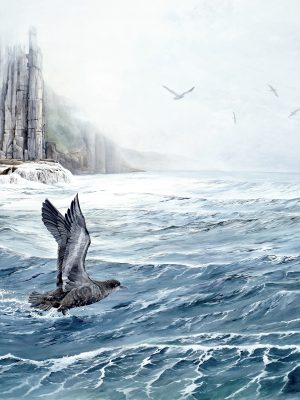
Cape Raoul, southern Tasmania
Watercolour and gouache on 640 gsm hot press Lana rag paper - H80 cms x W 100 cms. Unframed
The Short-tailed Shearwater (Ardenna tenuirostris) is Australia’s most numerous seabird. During breeding season, millions converge on many small islands around southern Australia, with their stronghold in Bass Strait. Cape Raoul is at the southernmost tip of the Tasman Peninsula in Tasmania. The cape features rock platforms, towering 300 metre cliffs, columns and off-shore islands.
Please get in contact for more information.
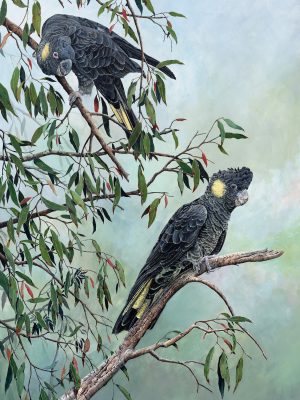
’I’m Up Here’! - Yellow tailed Black Cockatoos
Limited Edition print size: 100 cm x 80 cm. Printed on 310 gsm Museum quality art paper.
This is a signed limited edition print.
*Price includes postage anywhere within Australia.
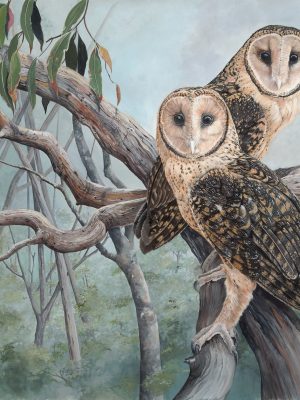
Limited Edition print size: 100 cm x 80 cm. Printed on 310 gsm Museum quality art paper.
'The Watchers' - Tasmanian Masked Owls
This is a signed limited edition print.
*Price includes postage anywhere within Australia
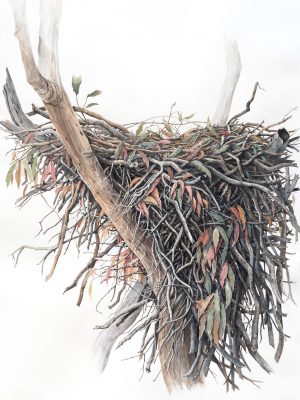
‘The Eyrie’ - Tasmanian Wedge-tailed Eagle Nest (Aquila audax fleayi)
Limited Edition print size: 100 cm x 80 cm. Printed on 310 gsm Museum quality art paper.
Wedge-tailed eagle nesting habitat is generally restricted to predominantly closed canopy old growth native forest, almost exclusively in tracts of tall eucalypt forest. Trees selected for nesting are among the largest in the locality, typically greater than 27 metres (89 ft) in height, with few exceptions. Nest trees normally occur on leeward slopes sheltered from prevailing strong winds.
The nest is a large structure of dead sticks, usually reused for years, often reaching considerable size. Nests 1.8 m across, 3 m deep and weighing about 400 kg are known. Nests have a shallow cup on the top, lined with fresh twigs and leaves. Sticks are added by a bird while it stands in the nest. If these sticks are dropped outside the nest, no effort is made to retrieve them. (With special thanks to Geoff ‘Hutcho’ Hutchinson for his fabulous reference images)
Listed: Endangered
This is a signed limited edition print.
*Price includes postage anywhere within Australia
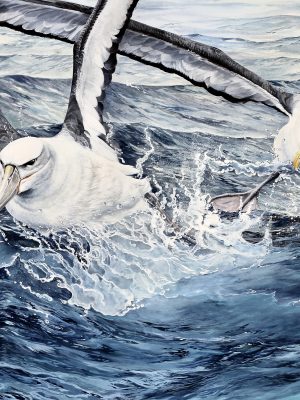
Limited Edition print size: 80 cm x 100 cm.
'The Feeding Frenzy ' - Tasmanian Shy Albatross (Thelassarche cauta)
The IUCN classifies this species as near threatened with less than 25,000 breeding animals. Today, longline fishing still impacts this species but their numbers have been maintained despite this threat. The shy albatross feeds by a combination surface-seizing and some pursuit diving – it has been recorded diving as deep as 5 m
*Price includes postage anywhere within Australia
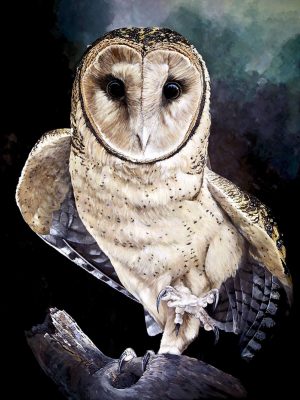
Limited edition print size 100 cm x 80 cm
The Tasmanian masked owl (Tyto novaehollandiae castanops) is a bird in the barn owl family Tytonidae that is endemic to the island state of Tasmania, Australia. It is the largest subspecies of the Australian masked owl, the largest Tyto owl in the world, and is sometimes considered a full species. The sub-specific name castanops, meaning “chestnut-faced”, comes from the colouring of the facial disc.
*Price includes postage anywhere within Australia.
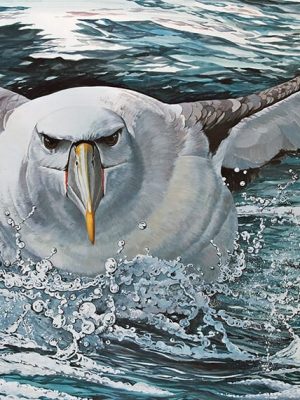
Print Size: 100cm x 60cm
Soaring majestically above the oceans between Australia and Africa, the shy albatross appears not to have a care in the world. Breeding only on Australian islands, it can live for up to 40 years and enjoys the partnership of a life-long mate.
Pairs are faithful –to each other and their breeding sites on just three remote islands off Tasmania. They breed annually and produce a single egg, which is incubated for 72 days. Both parents tend the demanding chick for the first five months of its life and that fledgling will return to the same breeding colony when it matures, but not until at least three years of age.
*Price includes postage anywhere within Australia.
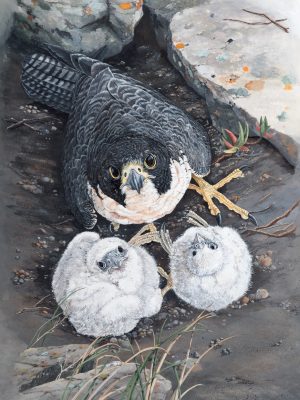
Limited Edition print size: 80 cm x 60 cm. Printed on 310 gsm Museum quality art paper.
'You're Late ' - Peregrine family (Falco peregrinus)
This female Peregrine was successfully rehabilitated at the Raptor Refuge of Tasmania, Kettering. A joy to watch and a very good news story.
The Peregrine Falcon is the embodiment of apex hunter; fastest animal in the world and master of the famous Peregrine ‘stoop’.
My portrait of Peregrine domesticity hopefully provides the viewer with a snapshot of another side to these magnificent raptors - that of protective maternal instinct and total commitment.
While the female incubates the eggs and the chicks newly hatched the family unit is fed on the nest by the male, hence her expression …’You’re Late’
(My sincere thanks to Luke O’Brien for his superb reference images)
This is a signed limited edition print.
*Price includes postage anywhere within Australia
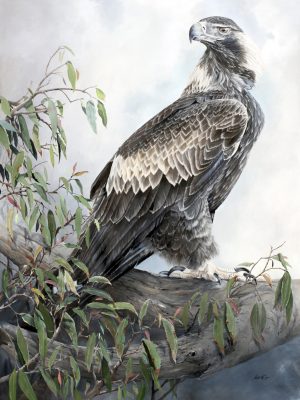
Juvenile Wedge-tailed eagle, Limited Edition Print size: 80 cm x 60 cm
The endangered Wedge-tailed Eagle subspecies Aquila audax fleayi occurs only in Tasmania. It is distinguished by its size (being Australia's largest bird of prey) and wedge-shaped tail. The total adult population has been estimated as less than 1000 birds. Principal threats include loss of nesting habitat, nest disturbance, collisions (with artificial structures, vehicles and aircraft), electrocution and persecution.
Aquila is a beloved member of The Raptor Refuge Inc. which is a not-for-profit organisation dedicated to caring and protecting Tasmania’s natural wildlife. https://www.raptorrefuge.com.au/

Print Size: 80cm x 60cm
The Australasian gannet (Morus serrator), also known as Australian gannet and tākapu, is a large seabird of the booby and gannet family, Sulidae. Adults are mostly white, with black flight feathers at the wingtips and lining the trailing edge of the wing. The central tail feathers are also black. The head is tinged buff-yellow, with a pale blue-grey bill edged in black, and blue-rimmed eyes. Young birds have mottled plumage in their first year, dark above and light below. The head is an intermediate mottled grey, with a dark bill. The birds gradually acquire more white in subsequent seasons until they reach maturity after five years.
*Price includes postage anywhere within Australia.
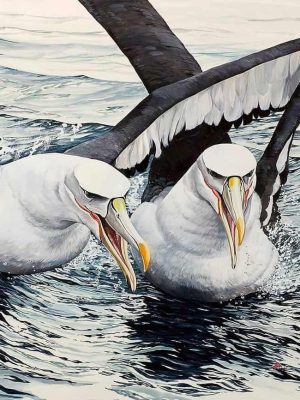
Print Size: 80cm x 60cm
Soaring majestically above the oceans between Australia and Africa, the shy albatross appears not to have a care in the world. Breeding only on Australian islands, it can live for up to 40 years and enjoys the partnership of a life-long mate.
Pairs are faithful –to each other and their breeding sites on just three remote islands off Tasmania. They breed annually and produce a single egg, which is incubated for 72 days. Both parents tend the demanding chick for the first five months of its life and that fledgling will return to the same breeding colony when it matures, but not until at least three years of age.
This is a signed Limited Edition print.
*Price includes postage anywhere within Australia.
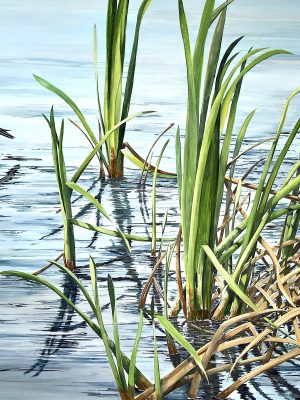
Limited Edition print size: 50 cm x 70 cm. Printed on 310 gsm Museum quality art paper.
'Reflections' - Welcome swallow
This is a signed limited edition print.
*Price includes postage anywhere within Australia
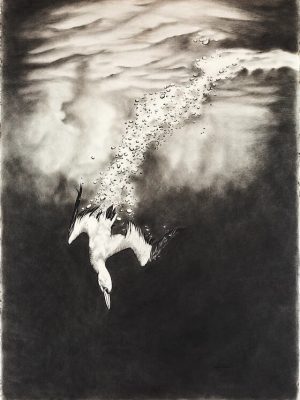
This Limited Edition Print is 60 cm x 80 cm
The Australasian gannet (Morus serrator), also known as Australian gannet and tākapu, is a large seabird of the booby and gannet family, Sulidae. Adults are mostly white, with black flight feathers at the wingtips and lining the trailing edge of the wing. These amazing birds dive from heights of 30 metres, entering the water at speeds of up to 100 km/h.
This is an Archival Print.
Price includes postage within Australia
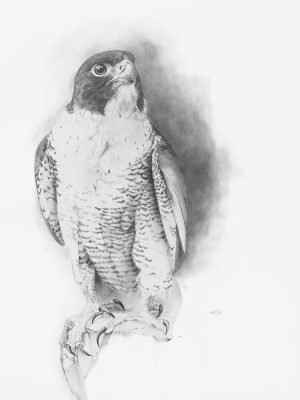
Peregrine falcon (Falco peregrinus)
All confirmed nests in Tasmania have been on cliffs. A site sheltered from heavy rain or high chill-factors is preferred and just a scrape is made to lay eggs.
Tasmania is a great place for peregrines but far from the best. The nesting population recovered from ravages of organochlorine pesticides in the 1960s, 1970s and into the 1980s, through legal protection in the early 1970s to now. With approximately 120 breeding pairs, the population has been relatively stable for some years now. Most are clustered in river valleys and along suitable coastline and on inshore islands and where close (< 4km apart) pairs tend to be evenly distributed due to their territorial nature. Nests are fiercely defended against all kinds of perceived threats and predators.
Size: A2 (59.4 cm x 42 cm). Printed on 310 gsm Museum quality art paper.
This is an archival print.
*Price includes postage anywhere within Australia
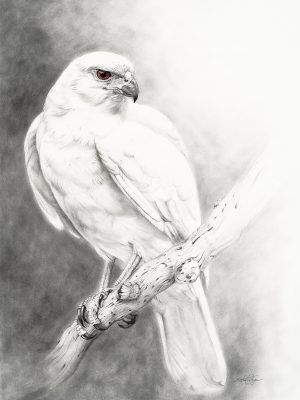
Grey goshawk - white morph (Accipiter novaehollandiae)
The grey morph has a pale grey head and back, dark wingtips, barred grey breast and tail, and white underparts. The white morph is the only bird of prey in the world to be entirely white.
Grey Goshawks are about 40–55 cm long, with wingspans of 70–110 cm. Females are much larger than males, weighing about 680 g. Males average 350 g.
Goshawks usually prey on mammals such as rabbits, possums, and bats. They may also eat birds, small reptiles, and insects. Females, due to their size, can catch larger prey than males.
Hunting is often done by stealth, and very successfully, but Grey Goshawks are willing to pursue their prey before catching it with their talons
Size: A2 (59.4 cm x 42 cm). Printed on 310 gsm Museum quality art paper.
This is an archival print.
*Price includes postage anywhere within Australia
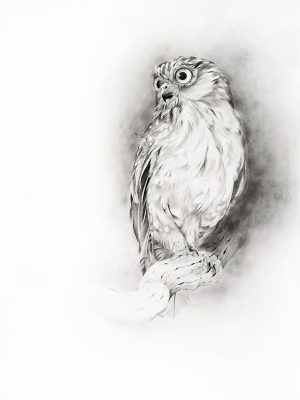
Southern Boobook owl (Ninox novaeseelandiae)
The Southern Boobook is the smallest and most common owl in Australia. It is identified by its plumage, which is dark chocolate-brown above and rufous-brown below, heavily streaked and spotted with white. The facial disc is chocolate brown and the eyes are large and yellowish. Tasmanian birds are smaller and more heavily spotted with white. Young Southern Boobooks are almost entirely buff-white below, with conspicuous dark brown facial discs. Like other owl species, the Southern Boobook is nocturnal.
Size: A2 (59.4 cm x 42 cm). Printed on 310 gsm Museum quality art paper.
This is an archival print.
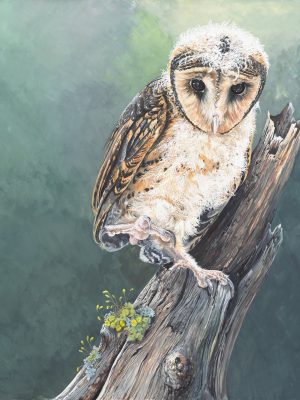
Immature Tasmanian Masked Owl (Tyto novaehollandiae castonops)
Montgomery (the owl) resides at the Raptor Refuge of Tasmania, Kettering. He enjoys educating school groups and takes his ambassadorial role very seriously.
(My sincere thanks to Luke O’Brien for his superb reference images)
This original piece is SOLD.
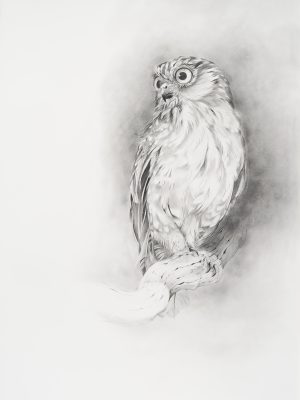
Southern Boobook owl (Ninox novaeseelandiae)
The Southern Boobook is the smallest and most common owl in Australia. It is identified by its plumage, which is dark chocolate-brown above and rufous-brown below, heavily streaked and spotted with white. The facial disc is chocolate brown and the eyes are large and yellowish. Tasmanian birds are smaller and more heavily spotted with white. Young Southern Boobooks are almost entirely buff-white below, with conspicuous dark brown facial discs. Like other owl species, the Southern Boobook is nocturnal.
This original piece is SOLD.
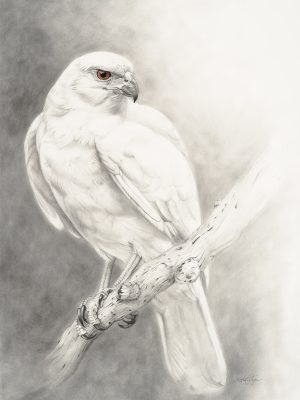
Grey goshawk - white morph (Accipiter novaehollandiae)
The grey morph has a pale grey head and back, dark wingtips, barred grey breast and tail, and white underparts. The white morph is the only bird of prey in the world to be entirely white.
Grey Goshawks are about 40–55 cm long, with wingspans of 70–110 cm. Females are much larger than males, weighing about 680 g. Males average 350 g.
Goshawks usually prey on mammals such as rabbits, possums, and bats. They may also eat birds, small reptiles, and insects. Females, due to their size, can catch larger prey than males.
Hunting is often done by stealth, and very successfully, but Grey Goshawks are willing to pursue their prey before catching it with their talons
This original piece is SOLD.
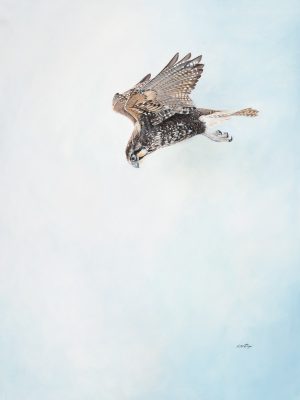
One of my favourite raptors. Usually around 40 cm to 50 cm long, they are found in light and dark forms and a variety of intermediates. They typically have red-brown heads with narrow black streaks with a light crown and off white chin. Wings are a spotted red-brown with dark brown quills. Beaks are light blue/grey, eyes are brown. The falcons make a loud cackle call uttered frequently. The brown falcon eats small mammals, including house mice and young rabbits. It also eats small birds, lizards, snakes and a variety of invertebrates particularly caterpillars, grasshoppers, crickets and beetles. Insects form the bulk of their diet during winter and the falcons often chase the insects on the ground!
(Sincere thanks once again to Clive Roper for his superb reference images)
This original piece is SOLD.
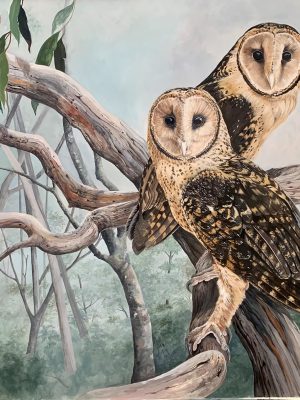
Tasmanian Masked Owls (Tyto novaehollandiae castonops)
Tasmanian Masked Owls are not only large, but robust. They weigh up to 1.26 kilograms with a wingspan of up to 129 centimetres. Their plumage is mainly a variable combination of browns and greys, generally darker than the other Australian subspecies. Females are considerably darker, as well as larger, than the males. They have broad, black-bordered, buff to chestnut facial discs, and fully feathered legs with powerful feet and long talons. The owls hunt at night, preying on a wide range of animals, from insects to mammals as large as rabbits, bandicoots and brushtail possums. (Sincere thanks once again to Dr Mehrdad Abbasian for his superb reference images)
Listed: Endangered.
This original piece is SOLD.

Tasmanian Wedge-tailed Eagle Nest (Aquila audax fleayi)
Wedge-tailed eagle nesting habitat is generally restricted to predominantly closed canopy old growth native forest, almost exclusively in tracts of tall eucalypt forest. Trees selected for nesting are among the largest in the locality, typically greater than 27 metres in height, with few exceptions. Nest trees normally occur on leeward slopes sheltered from prevailing strong winds.
The nest is a large structure of dead sticks, usually reused for years, often reaching considerable size. Nests 1.8 m across, 3 m deep and weighing about 400 kg are known. Nests have a shallow cup on the top, lined with fresh twigs and leaves. Sticks are added by a bird while it stands in the nest. If these sticks are dropped outside the nest, no effort is made to retrieve them. (With special thanks to Geoff ‘Hutcho’ Hutchinson for his fabulous reference images)
Listed: Endangered.
This original piece is SOLD.

Peregrine falcon (Falco peregrinus)
All confirmed nests in Tasmania have been on cliffs. A site sheltered from heavy rain or high chill-factors is preferred and just a scrape is made to lay eggs.
Tasmania is a great place for peregrines but far from the best. The nesting population recovered from ravages of organochlorine pesticides in the 1960s, 1970s and into the 1980s, through legal protection in the early 1970s to now. With approximately 120 breeding pairs, the population has been relatively stable for some years now. Most are clustered in river valleys and along suitable coastline and on inshore islands and where close (< 4km apart) pairs tend to be evenly distributed due to their territorial nature. Nests are fiercely defended against all kinds of perceived threats and predators.
This original piece is SOLD.

Feathers are epidermal growths that form a distinctive outer covering, or plumage on avian species. They are considered the most complex integumentary structures found in vertebrates and a premier example of a complex evolutionary novelty. As well as controlling flight and regulating temperature, they often attract more than just other birds with their beauty.
This original piece is FOR SALE. Please get in contact for more information.

Tasmanian Wedge-tailed eagle (Aquila audax fleayi) feather.
The average wingspan for the Tasmanian Wedge-tailed eagle is typically is between 182 and 232 cm. The largest wingspan ever verified for an eagle was for this species. A female killed in Tasmania in 1931 had a wingspan of 284 cm, another female measured barely smaller at 279 cm.
This original piece is FOR SALE. Please get in contact for more information.

This female Peregrine was successfully rehabilitated at the Raptor Refuge of Tasmania, Kettering. A joy to watch and a very good news story.
The Peregrine Falcon is the embodiment of apex hunter; fastest animal in the world and master of the famous Peregrine ‘stoop’.
My portrait of Peregrine domesticity hopefully provides the viewer with a snapshot of another side to these magnificent raptors - that of protective maternal instinct and total commitment.
While the female incubates the eggs and the chicks newly hatched the family unit is fed on the nest by the male, hence her expression …’You’re Late’
(My sincere thanks to Luke O’Brien for his superb reference images)
Award of Excellence - Holmes Art Prize for Australian Bird Art, QLD 2021
This original piece is SOLD. To view available limited edition prints, please click here.
Please get in contact for more information.
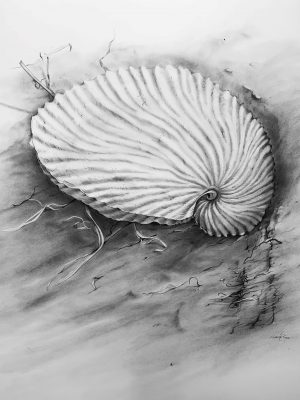
100 cm x 80 cm Framed. Graphite on 640 gsm hot press rag paper
The Argonaut, or paper nautilus, is actually a pelagic octopus. Females make a parchment-like shell (up to 30cm) which is used to carry incubating eggs and to trap surface air, which helps them maintain buoyancy.
This original piece is SOLD.
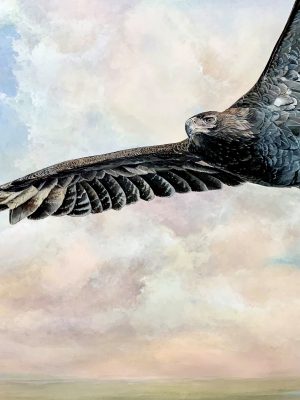
Tasmanian Wedge-tailed eagle (Aquila audax fleayi), Gravelly Beach, Tasmania
Watercolour and gouache on 640 gsm hot press rag paper - 100 cms x 120 cms.
The Wedge-tailed Eagle has long wings (wingspan 2.3 m), a characteristic long, wedge-shaped tail, and legs that are feathered all the way to the base of the toes. The bill is pale pink to cream, the eye brown to dark brown, and the feet off-white. Young Wedge-tailed Eagles are mid brown in colour with reddish-brown heads and wings. They become progressively blacker for at least the first ten years of their lives; adults are mostly dark blackish-brown. The only difference in plumage between the sexes is that a female adult is generally slightly paler than her mate. Females (4.2 kg - 5.3 kg) are also larger and heavier than males (3.2 kg up to 4.0 kg). Wedge-tailed Eagles are Australia's largest raptors (birds of prey). The Tasmanian subspecies (Aquila audax fleayi) is listed federally as endangered.
This original piece is SOLD. TO view available limited edition prints, please click here.
Please get in contact for more information.
110 cm x 90 cm Graphite on 640 gsm hot press rag paper
The Aberdeen Angus, sometimes simply Angus, is a Scottish breed of small beef cattle. It derives from cattle native to the counties of Aberdeenshire and Angus in north-eastern Scotland. Angus cattle were first introduced to Tasmania (then known as Van Diemen's Land) in the 1820s and to the southern mainland in 1840. The breed is now found in all Australian states and territories, including King Island. With lush pastures and a temperate climate, the island is perfect for breeding the happiest, grass-fed cattle on the planet.
This original piece is SOLD. To view our limited edition prints click here.

Juvenile Tasmanian Wedge-tailed eagle, watercolour and gouache. 110 cms x 80 cms on 640 gsm hot press rag paper
The endangered Wedge-tailed Eagle subspecies Aquila audax fleayi occurs only in Tasmania. It is distinguished by its size (being Australia's largest bird of prey) and wedge-shaped tail. The total adult population has been estimated as less than 1000 birds. Principal threats include loss of nesting habitat, nest disturbance, collisions (with artificial structures, vehicles and aircraft), electrocution and persecution.
Aquila is a beloved member of The Raptor Refuge Inc. which is a not-for-profit organisation dedicated to caring and protecting Tasmania’s natural wildlife. https://www.raptorrefuge.com.au/
This original piece is SOLD.

Watercolour and gouache on Ampersand Claybord. - H40 cms x W 40 cms. Framed
The Eastern Spinebill (Acanthorhynchus tenuirostris) inhabits shrubs in open eucalypt forests, as well as shrubland and suburban gardens. They use their long, slender, de-curved bills to probe deep into flowers to feed on the sweet nectar.
This original piece is SOLD. To see limited edition prints, please click here

Cape Raoul, southern Tasmania
Watercolour and gouache on 640 gsm hot press Lana rag paper - H120 cms x W 150 cms. Framed
The Short-tailed Shearwater (Ardenna tenuirostris) is Australia’s most numerous seabird. During breeding season, millions converge on many small islands around southern Australia, with their stronghold in Bass Strait. Cape Raoul is at the southernmost tip of the Tasman Peninsula in Tasmania. The cape features rock platforms, towering 300 metre cliffs, columns and off-shore islands.
This original piece is SOLD
Please get in contact for more information.

Print Size: 100 cm x 80 cm
With its combination of royal-blue plumage on its upperparts contrasting with orange on its underparts, the Azure Kingfisher is one of the smallest and most dazzling kingfishers in Australia. This diminutive species inhabits the vegetation beside waterways and other wetlands, where it often perches on low, overhanging branches, searching for its prey of fish, crustaceans and aquatic insects, captured by shallow plunging into the water. Anglers on lonely rivers are sometimes surprised to find an Azure Kingfisher perched quietly on their fishing rods instead of a branch.
This is an archival print. To view our limited edition prints click here.
*Price includes postage anywhere within Australia.

The Tasmanian masked owl (Tyto novaehollandiae castanops) is a bird in the barn owl family Tytonidae that is endemic to the island state of Tasmania, Australia. It is the largest subspecies of the Australian masked owl, the largest Tyto owl in the world, and is sometimes considered a full species. The sub-specific name castanops, meaning “chestnut-faced”, comes from the colouring of the facial disc.
This original print is SOLD. To view it as a limited edition print, click here.
